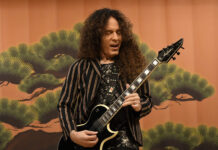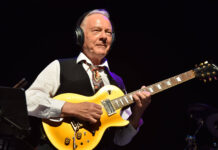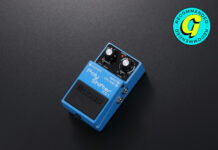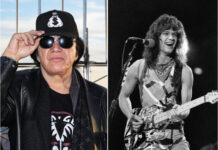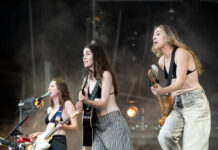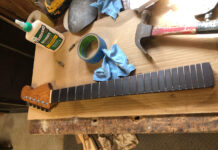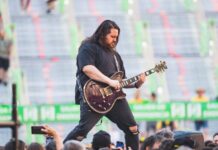
“Every time you come back to The Beatles, you start a new relationship with their music”: Joel Paterson on the Fab Four
Self-described “Mid-Century Music Re-enactor” Joel Paterson has a refreshingly retro attitude towards being a guitarist. “I’m so sorry, I had my phone off. I’ve been practicing all day for a gig tonight,” he says, answering our call some two hours after our agreed interview time. “You know, as guitarists, we have to get out of our rooms. There are too many guitar videos where we’re all sitting at home. What’s going on here?!”
What’s going on is that the Chicago native has just released Let It Be Guitar, an album of Beatles classics through which he explores the Fab Four’s music via the Kodachrome and slapback echo textures of guitarists who have influenced his playing over the years.
“I’m kind of a music nerd and I’ve gone through a lot of stages,” says Paterson. “Having started with country blues, I have since gone through phases of western swing, jazz, etc, so by the time I made this record I wanted to take all my favourite influences and use the songs of The Beatles as a way to explore different styles. The Beatles were doing exactly the same thing.”
The record also provided an opportunity for Paterson to pay tribute to some of his favourite session players. “I have a deep love for the unsung heroes of the recording studio, those crack guitar players who are responsible for so many hit records,” he says. “Guys like Ernest Ranglin, who was the Studio One [Jamaica’s answer to Motown] guitarist, for example. Nobody knows his name but he was on all those amazing early ska and reggae records. He did a cover of You Won’t See Me from Rubber Soul and it’s the best Beatles cover I have ever heard.
Image: Paula Borman and Paul Vriend“I played it to my trio when we went into the studio to record the basic tracks for No Reply and they loved it. I said: ‘I don’t know how the hell to play like that!’ but on the spur of the moment we started jamming around that groove and I tried to pay tribute to Ranglin’s style so it was more about feel than technique – very spontaneous. Alex Hall, our engineer, who also played drums on that recording, did a fantastic job getting the production to sound like that early Studio One sound. I’m very grateful. I don’t know what that style is – Jamaican ska with a Bigbsy.
Those are the kinds of guitarists I like. Guys like Hank Garland too. He played the guitar lick on Elvis Presley’s Little Sister but he’s also one of the most burning jazz players ever. Those are the players that I gravitate to.”
Country boy
You probably don’t think of country when you think of The Beatles but Paterson is keen to emphasise the strong pull that US country and blues music had on the band.
“If you listen to some of the early BBC sessions where they’re playing live, The Beatles were one of the best rockabilly bands ever,” says Paterson enthusiastically. “George Harrison did a lot of little tributes to Chet Atkins too – you can tell he was a Chet fan. And The Beatles incorporated lots of country, blues and soul.
“Listen to their recording of I Don’t Want To Spoil The Party. They’d obviously got hold of a Buck Owens record and had a Buck Owens phase. The same is true on Act Naturally. That was their take on US country so I took the idea and went further with it, making it even more like 1960s Nashville country music than they did. Stylistically, it doesn’t sound like The Beatles except for the melodies and harmonies, which I was very picky about.”
Inevitably for an artist who leans so heavily on mid 20th-century textures, the conversation turns to the genius of Les Paul. “Any time you hear little overdubbed harmony parts, that’s influenced by Les Paul,” says Paterson. “Honey Pie in particular was an attempt to do one of his ‘guitar orchestra’ recordings, where you have a guitar mimicking all the parts of a big band. You have a little trumpet section, which is the guitars played up high, and then your sax section, which is more the mids.
Usually these are clusters of four-part harmonies that you overdub. With Honey Pie, I sat down for a week and forced myself to come up with the harmonies. That song means a lot to me, as it’s George Martin’s tour de force, arranging a 1920s-style big band, but everything you hear on my recording, aside from the bass, comes from a guitar.
“Nothing on this record featured speeding up the guitar. I dabbled with that technique on my album Handful of Strings and it’s kind of a misconception that everything is sped up on a Les Paul record. That’s really not the case. A lot of what you’re hearing is him playing individual notes in four-part harmonies up the neck. That’s one good thing about a Les Paul guitar, you can really reach those notes. Once you start getting into this style and listening to people who did these overdubbed records, you can get a feel for what is sped up and what isn’t and there’s not as much as you might think. When it’s sped up, it’s obvious and very cartoonish sounding.”
View this post on Instagram
A lot of people (actually just a small smattering of guitar geeks) have asked me how I record all the background harmony parts on my multi-track albums. Well it’s always like this – staring into the abyss for hours with my 1969 Goldtop, wondering how the heck Les Paul, Jorgen Ingmann and Buddy Merrill laid down all those parts for hundreds of songs (I don’t think they had to check email), then I get motivated and slowly build up my own arrangements with a lot of trial and error and coffee. And then as soon as I get on a roll I have to run to a gig, and then I repeat the process the next day. Maybe in ten years I’ll be able to sell you this record. In the meantime, keep listening to my Christmas songs until you want to .
A post shared by Joel Paterson (@thejoelpaterson) on Oct 4, 2018 at 12:16pm PDT
The guitar’s the star
Paterson is known for his beautiful vintage instruments, so it’s no surprise that we take a detour when the conversation turns to the instrument itself. But the roots player has some stern words for the guitar world.
“I’m happy to talk about the guitars I use as long as it’s in the context of the music they make, what they sound like and why, because that’s what guitars are to me,” he says. “You can see what I recorded with. It’s right there on the album cover and I chose those guitars for a simple reason: they’re mine.
“The style of music I’ve been into over the years lends itself to vintage archtop guitars and that’s always been my thing, so I was always looking for deals on archtops and I’ve been wheeling and dealing like that for years. I didn’t set out to solely play vintage guitars but they were the instruments that sounded better, looked better, lasted longer and played better. There’s no doubt about that as far as I’m concerned.
“If you want to ask me about the vintage-guitar market these days – that’s an unfortunate tangent. I certainly don’t want to come off as negative but there is a lot of greed and disinformation going on in the guitar world.
Image: Paula Borman and Paul Vriend“There’s a huge thing going on with people treating guitars almost like safari trophies, just hanging them on the wall, and that really disgusts me. It’s taking nice instruments out of the hands of people, especially good young guitar players, who could really benefit from them. Back in the day, there were always certain models that were out of reach because they were what the rockstars played – ’bursts, 1950s Strats and dot neck 335s from 1959, that sort of thing – and that’s fine. But that’s rockstars. Not so long ago, you could still swing a deal on a beat-up 175 to get you going. Now it’s impossible to do anything. There are a lot of people just sitting on guitars that go unsold for years. What’s going on?!
“Twenty years ago, I would play a gig and someone would come up to me and say: ‘Oh, man, that’s a cool guitar, it sounds great’. Now it’s: ‘Hey, that’s a cool guitar, what year is it?’, as if they’re working out the value in their heads – and usually they’re way off. I’m sure outside the US it’s even harder in some cases to find good American guitars. It’s always been that way.”
Semi-seduction
With a choice of vintage guitars at his disposal, Paterson employs what is one of the world’s sexiest hollowbodies as his main instrument. “I have a little stable of guitars that I go to when I record and gig with, and everybody knows that the 1956 ES-295 is my main instrument,” he says. “It’s the one I travel with. I’ve played thousands of gigs with that guitar. It’s been with me forever and it’s all over anything I record.
“I’ve kept it pretty much original but it’s had a few modifications over the years. I added a Bigsby to it and had it refretted just to deck it out and make it do what everything I want it to do. You can play jazz, rockabilly and rock ’n’ roll on it, and I have it set up so you can bend the strings and play blues. That’s the guitar I reach for first.
View this post on Instagram
Today I tried to learn Roy Nichols’ incredible solo from the 1956 record “Charming Betsy” by The Farmer Boys. Roy later became famous in the ‘60s playing with Merle Haggard’s Strangers. @dekedickerson made a post on Facebook the other day asking guitarists to show their best guess on how to play this crazy country solo. It was a nice little workout – thanks, Deke for the motivation and another great way for me to avoid emails. And as always, it’s all an attempt to show you my Chicago show calendar for the week: Thursday: Devil in a Woodpile at The Hideout, 6 to 7:30pm Thursday: (after the Hideout), Swing duo with Beau Sample at Orso’s restaurant @orsosrestaurant from 8 to 10pm Friday: The Western Elstons at Goldyburger in Oak Park, 9pm Saturday: The Modern Sounds at The California Clipper, 10:30pm Sunday: Organ Trio with Chris Foreman and Alex Hall at The Green Mill, 11pm to 2am. #roynichols #countrypicking #countryguitar #vintageguitar #guitarvideo #flatpicking #vintagegibson #gibsones295 #gibsones #gibsones295 #p90s #soundonsound #echoplex
A post shared by Joel Paterson (@thejoelpaterson) on Jan 10, 2019 at 2:04pm PST
“When it comes to strings, people might expect me to use flatwounds, and I do have a couple of guitars set up like that at home, but the majority of the time I don’t use them. I like them but I don’t. They sound cool but I find them limiting and they can be a bit weird with a Bigsby too. And when I sit around the house and play my archtops acoustically, they always sound so dead with flatwounds. It kind of bums me out. However, I love a low twangy guitar sound recorded with flatwounds – that’s the best.”
Like many artists, Paterson has a tried-and-tested formula for finding his sound on stage and in the studio. “My set-ups on stage and in the studio are completely different,” he says. “When I use an amp in the studio, it’s usually a small Gibson amp like a GA-6 or a GA-20, or a Fender Princeton Reverb. When I play live, it’s usually a tweed Fender Pro or, at smaller gigs, the Princeton, sometimes a Vibrolux.
“When I record direct in the studio I go through an Echoplex and into a 1963 Fender reverb tank and eventually into ProTools, which I’m basically using as a tape recorder – I don’t use any plug-ins or effects or anything like that; I want my sound to be as pure as possible. One of the joys of going direct is that you can sit at home and work on harmonies in the middle of the night, which would not be practical in the studio. It’s not just for clean sounds either. You couldn’t get that distorted sound on Revolution without going direct so there’s a precedent.
“All the guitar sounds I love were recorded on small amps set on about one-and-a-half. When you look at pictures of people in Nashville, they’d have a little Gibson amp right above their heads. The physics of that, that when they were playing next to an upright-bass player and a piano player they couldn’t have turned up loud at all – that’s the sound right there, and the different tones come more from the guitars than the amp settings. And you know, we’re not at Abbey Road here, we’re in a couple of tiny homemade studios in Chicago.”
Image: Paula Borman and Paul VriendFab fans
The music of The Beatles carries a lot of sentimental weight for Joel and he’s translated it into an emotive album replete with gorgeous re-workings of iconic songs. As for its standout moments, Paterson says: “Because is the one I worked the most on, as it has some of the most intense harmonies ever. It’s the most awesome three-part harmony but it plays tricks on you. The Beatles triple-tracked that one on each voice and hard-panned it, so it’s really dense. I tried to overdub those harmonies one note at a time but it came out sounding like Queen. So I worked out how to play it on one guitar. In this case, everything on there is my Jazzmaster. When I play live, Jazzmasters sometimes sound a bit thin to me, but on record they fit perfectly – not too much bass but not as thin as a Telecaster, so I like that a lot.
“Girl was recorded during the same session as Michelle and there’s a bunch of weird overdubs on it. The Beatles’ original has this ‘sigh’ in it by John Lennon. It’s basically the entire hook of the song. I was trying to work out how to do that on guitar somehow. Eventually I managed to do it with feedback on my Echoplex. Basically, you crank the Echoplex until it starts feeding back and then you turn it down real quick. It’s hard to make it sound smooth before it goes too sci-fi but I got it. There’s nothing digital here, just my guitar, the Echoplex and a Fender reverb tank.
“Things We Said Today was recorded direct using an early 1950s ES-350 in my home studio, with an echo-led and a reverb tank. I wanted to sound like Jurgen Ingman, who was kind of the Danish Les Paul. He did a version of Apache in 1960, playing an L7 with P-90s straight into the desk. I was trying to pay tribute to him so I used my 350 with P-90s. The song is in A minor, just like Apache, so I had fun with it.
View this post on Instagram
I’m getting back into the swing of things here in Chicago after a whirlwind trip to Memphis for the @ameripolitan awards. Tonight (and every Thursday) I play a doubleheader; starting with Devil in a Woodpile at The Hideout from 6 to 7:30pm and finishing up at Orso’s Restaurant in Old Town from 8 to 10pm @orsosrestaurant. If you like my guitar videos, the duo show I do with Beau Sample at Orso’s is the closest thing I play live to this sound and repertoire. Have I filmed “Sheik of Araby” already? I can’t remember. I never know how to end this one, so I played just about all of ‘em here except “Shave and a Haircut.” #guitarvideo #fingerstyle #fingerstyleguitar #travispicking #epiphone #epiphonebroadway #vintageguitar #howdoiendthis #vintageepiphone #bigsby #jazzguitar #westernswing
A post shared by Joel Paterson (@thejoelpaterson) on Feb 28, 2019 at 1:59pm PST
“This Boy was played on a pedal-steel guitar. It’s an Emmons, as in Buddy Emmons, probably the world’s greatest pedal-steel player. I recorded it because I wanted to do that amazing three-part harmony and I was trying to learn it on lap-steel but some of the bends and chords worked better on pedal-steel because I could really bend into them with the foot pedals. I love that harmony, and I learnt it note for note. The sound of this arrangement was obviously inspired by Sleepwalk [Santo & Johnny’s ethereal instrumental classic], although that’s not actually a pedal-steel. I just wanted that vibe, a sort of ’59/’60 Nashville sound. That’s what I was going for there.
“Her Majesty is 26 seconds of my Gibson J-50 and you’d be amazed at how many people don’t know that original recording and have come up to me saying that the CD is defective. You know, Americans don’t always know as much about The Beatles as you might think.”
The universal appeal of the Fab Four has inspired countless musicians and Paterson is no exception. “As far as The Beatles are concerned, I’ve been listening to their music my whole life,” he says. “When I started playing guitar, I was so fixated on the identity of learning to play lead guitar and the blues that it never dawned on me to play The Beatles’ music. But I’ve noticed that every time you come back to The Beatles, you start a new relationship with their music. It’s like you rediscover them about a million times over the course of your life and there’s always something new.”
Let It Be Guitar is out now on Bloodshot Records.
The post “Every time you come back to The Beatles, you start a new relationship with their music”: Joel Paterson on the Fab Four appeared first on Guitar.com | All Things Guitar.
Source: www.guitar-bass.net

